|
PLearn 0.1
|
|
PLearn 0.1
|
Layer in an RBM formed with binomial units. More...
#include <RBMBinomialLayer.h>
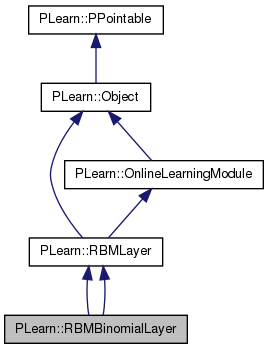
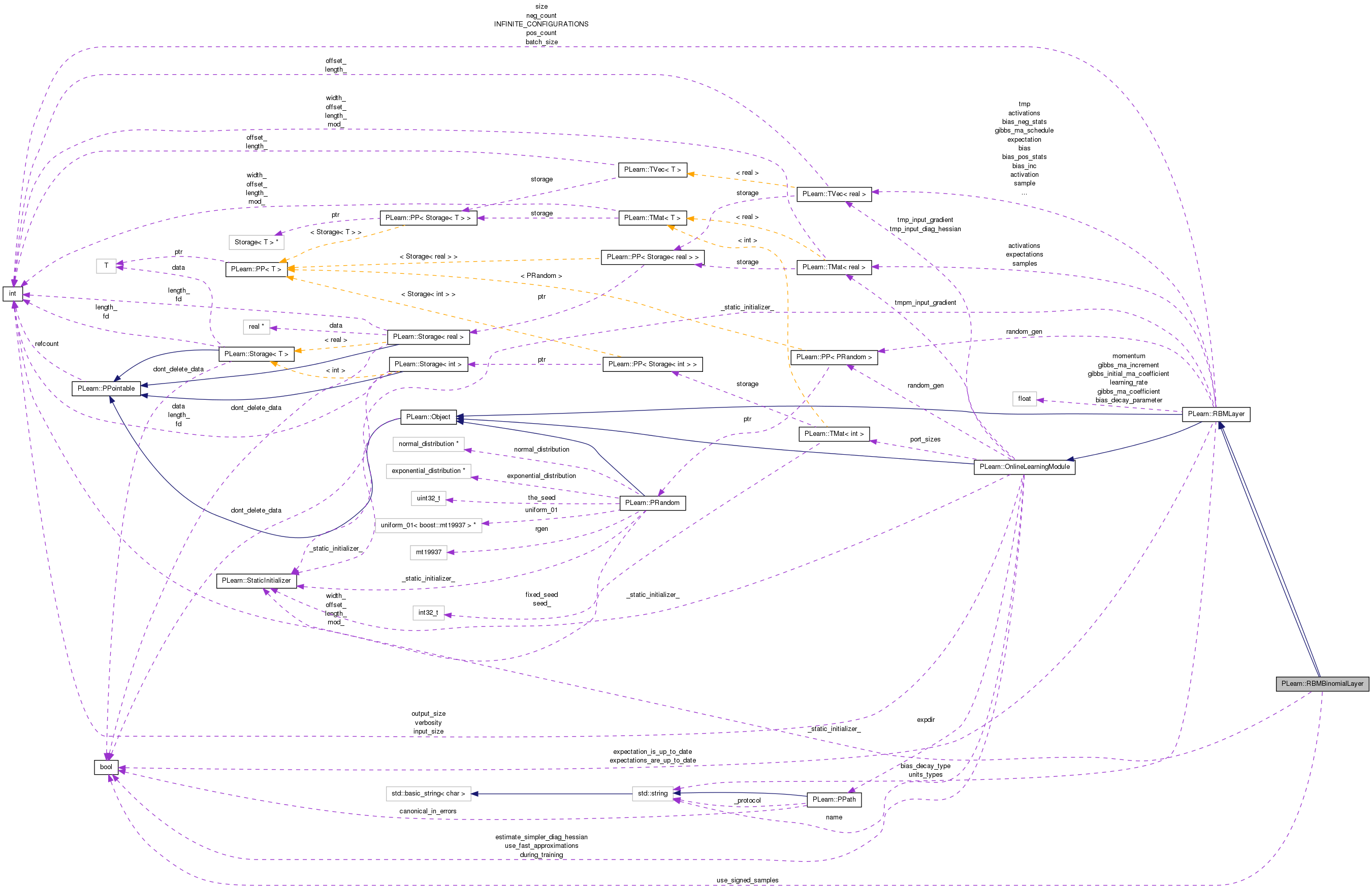
Public Member Functions | |
| RBMBinomialLayer () | |
| Default constructor. | |
| RBMBinomialLayer (int the_size) | |
| Constructor from the number of units. | |
| virtual void | getUnitActivations (int i, PP< RBMParameters > rbmp, int offset=0) |
| Uses "rbmp" to obtain the activations of unit "i" of this layer. | |
| virtual void | getAllActivations (PP< RBMParameters > rbmp, int offset=0) |
| Uses "rbmp" to obtain the activations of all units in this layer. | |
| virtual void | generateSample () |
| generate a sample, and update the sample field | |
| virtual void | computeExpectation () |
| compute the expectation | |
| virtual void | bpropUpdate (const Vec &input, const Vec &output, Vec &input_gradient, const Vec &output_gradient) |
| back-propagates the output gradient to the input | |
| virtual string | classname () const |
| virtual OptionList & | getOptionList () const |
| virtual OptionMap & | getOptionMap () const |
| virtual RemoteMethodMap & | getRemoteMethodMap () const |
| virtual RBMBinomialLayer * | deepCopy (CopiesMap &copies) const |
| virtual void | build () |
| Post-constructor. | |
| virtual void | makeDeepCopyFromShallowCopy (CopiesMap &copies) |
| Transforms a shallow copy into a deep copy. | |
| RBMBinomialLayer (real the_learning_rate=0.) | |
| Default constructor. | |
| RBMBinomialLayer (int the_size, real the_learning_rate=0.) | |
| Constructor from the number of units. | |
| virtual void | generateSample () |
| generate a sample, and update the sample field | |
| virtual void | generateSamples () |
| Inherited. | |
| virtual void | computeExpectation () |
| Compute expectation. | |
| virtual void | computeExpectations () |
| Compute mini-batch expectations. | |
| virtual void | fprop (const Vec &input, Vec &output) const |
| forward propagation | |
| virtual void | fprop (const Mat &inputs, Mat &outputs) |
| Batch forward propagation. | |
| virtual void | fprop (const Vec &input, const Vec &rbm_bias, Vec &output) const |
| forward propagation with provided bias | |
| virtual void | bpropUpdate (const Vec &input, const Vec &output, Vec &input_gradient, const Vec &output_gradient, bool accumulate=false) |
| back-propagates the output gradient to the input | |
| virtual void | bpropUpdate (const Vec &input, const Vec &rbm_bias, const Vec &output, Vec &input_gradient, Vec &rbm_bias_gradient, const Vec &output_gradient) |
| back-propagates the output gradient to the input and the bias | |
| virtual void | bpropUpdate (const Mat &inputs, const Mat &outputs, Mat &input_gradients, const Mat &output_gradients, bool accumulate=false) |
| Back-propagate the output gradient to the input, and update parameters. | |
| virtual real | fpropNLL (const Vec &target) |
| Computes the negative log-likelihood of target given the internal activations of the layer. | |
| virtual void | fpropNLL (const Mat &targets, const Mat &costs_column) |
| virtual real | fpropNLL (const Vec &target, const Vec &weights) |
| Computes the weighted negative log-likelihood of target given the internal activations of the layer. | |
| virtual void | bpropNLL (const Vec &target, real nll, Vec &bias_gradient) |
| Computes the gradient of the negative log-likelihood of target with respect to the layer's bias, given the internal activations. | |
| virtual void | bpropNLL (const Mat &targets, const Mat &costs_column, Mat &bias_gradients) |
| virtual real | energy (const Vec &unit_values) const |
| compute -bias' unit_values | |
| virtual real | freeEnergyContribution (const Vec &unit_activations) const |
Computes  ) This quantity is used for computing the free energy of a sample x in the OTHER layer of an RBM, from which unit_activations was computed. ) This quantity is used for computing the free energy of a sample x in the OTHER layer of an RBM, from which unit_activations was computed. | |
| virtual void | freeEnergyContributionGradient (const Vec &unit_activations, Vec &unit_activations_gradient, real output_gradient=1, bool accumulate=false) const |
Computes gradient of the result of freeEnergyContribution  with respect to unit_activations. with respect to unit_activations. | |
| virtual int | getConfigurationCount () |
| Returns a number of different configurations the layer can be in. | |
| virtual void | getConfiguration (int conf_index, Vec &output) |
| Computes the conf_index configuration of the layer. | |
| virtual string | classname () const |
| virtual OptionList & | getOptionList () const |
| virtual OptionMap & | getOptionMap () const |
| virtual RemoteMethodMap & | getRemoteMethodMap () const |
| virtual RBMBinomialLayer * | deepCopy (CopiesMap &copies) const |
| virtual void | build () |
| Post-constructor. | |
| virtual void | makeDeepCopyFromShallowCopy (CopiesMap &copies) |
| Transforms a shallow copy into a deep copy. | |
Static Public Member Functions | |
| static string | _classname_ () |
| static OptionList & | _getOptionList_ () |
| static RemoteMethodMap & | _getRemoteMethodMap_ () |
| static Object * | _new_instance_for_typemap_ () |
| static bool | _isa_ (const Object *o) |
| static void | _static_initialize_ () |
| static const PPath & | declaringFile () |
| static string | _classname_ () |
| static OptionList & | _getOptionList_ () |
| static RemoteMethodMap & | _getRemoteMethodMap_ () |
| static Object * | _new_instance_for_typemap_ () |
| static bool | _isa_ (const Object *o) |
| static void | _static_initialize_ () |
| static const PPath & | declaringFile () |
Public Attributes | |
| bool | use_signed_samples |
Static Public Attributes | |
| static StaticInitializer | _static_initializer_ |
Static Protected Member Functions | |
| static void | declareOptions (OptionList &ol) |
| Declares the class options. | |
| static void | declareOptions (OptionList &ol) |
| Declares the class options. | |
Private Types | |
| typedef RBMLayer | inherited |
| typedef RBMLayer | inherited |
Private Member Functions | |
| void | build_ () |
| This does the actual building. | |
| void | build_ () |
| This does the actual building. | |
Layer in an RBM formed with binomial units.
Definition at line 53 of file DEPRECATED/RBMBinomialLayer.h.
typedef RBMLayer PLearn::RBMBinomialLayer::inherited [private] |
Reimplemented from PLearn::RBMLayer.
Definition at line 55 of file DEPRECATED/RBMBinomialLayer.h.
typedef RBMLayer PLearn::RBMBinomialLayer::inherited [private] |
Reimplemented from PLearn::RBMLayer.
Definition at line 54 of file RBMBinomialLayer.h.
| PLearn::RBMBinomialLayer::RBMBinomialLayer | ( | ) |
| PLearn::RBMBinomialLayer::RBMBinomialLayer | ( | int | the_size | ) |
Constructor from the number of units.
Definition at line 55 of file DEPRECATED/RBMBinomialLayer.cc.
References PLearn::TVec< T >::resize(), and PLearn::sample().
{
size = the_size;
units_types = string( the_size, 'l' );
activations.resize( the_size );
sample.resize( the_size );
expectation.resize( the_size );
expectation_is_up_to_date = false;
}

| PLearn::RBMBinomialLayer::RBMBinomialLayer | ( | real | the_learning_rate = 0. | ) |
Default constructor.
Definition at line 53 of file RBMBinomialLayer.cc.
:
inherited( the_learning_rate ),
use_signed_samples( false )
{
}
Constructor from the number of units.
Definition at line 59 of file RBMBinomialLayer.cc.
References PLearn::RBMLayer::activation, PLearn::RBMLayer::bias, PLearn::RBMLayer::bias_neg_stats, PLearn::RBMLayer::bias_pos_stats, PLearn::RBMLayer::expectation, PLearn::TVec< T >::resize(), PLearn::RBMLayer::sample, and PLearn::RBMLayer::size.
:
inherited( the_learning_rate ),
use_signed_samples( false )
{
size = the_size;
activation.resize( the_size );
sample.resize( the_size );
expectation.resize( the_size );
bias.resize( the_size );
bias_pos_stats.resize( the_size );
bias_neg_stats.resize( the_size );
}

| string PLearn::RBMBinomialLayer::_classname_ | ( | ) | [static] |
Reimplemented from PLearn::RBMLayer.
Definition at line 49 of file DEPRECATED/RBMBinomialLayer.cc.
| static string PLearn::RBMBinomialLayer::_classname_ | ( | ) | [static] |
Reimplemented from PLearn::RBMLayer.
| OptionList & PLearn::RBMBinomialLayer::_getOptionList_ | ( | ) | [static] |
Reimplemented from PLearn::RBMLayer.
Definition at line 49 of file DEPRECATED/RBMBinomialLayer.cc.
| static OptionList& PLearn::RBMBinomialLayer::_getOptionList_ | ( | ) | [static] |
Reimplemented from PLearn::RBMLayer.
| RemoteMethodMap & PLearn::RBMBinomialLayer::_getRemoteMethodMap_ | ( | ) | [static] |
Reimplemented from PLearn::RBMLayer.
Definition at line 49 of file DEPRECATED/RBMBinomialLayer.cc.
| static RemoteMethodMap& PLearn::RBMBinomialLayer::_getRemoteMethodMap_ | ( | ) | [static] |
Reimplemented from PLearn::RBMLayer.
Reimplemented from PLearn::RBMLayer.
Definition at line 49 of file DEPRECATED/RBMBinomialLayer.cc.
Reimplemented from PLearn::RBMLayer.
| static Object* PLearn::RBMBinomialLayer::_new_instance_for_typemap_ | ( | ) | [static] |
Reimplemented from PLearn::Object.
| Object * PLearn::RBMBinomialLayer::_new_instance_for_typemap_ | ( | ) | [static] |
Reimplemented from PLearn::Object.
Definition at line 49 of file DEPRECATED/RBMBinomialLayer.cc.
| StaticInitializer RBMBinomialLayer::_static_initializer_ & PLearn::RBMBinomialLayer::_static_initialize_ | ( | ) | [static] |
Reimplemented from PLearn::RBMLayer.
Definition at line 49 of file DEPRECATED/RBMBinomialLayer.cc.
| static void PLearn::RBMBinomialLayer::_static_initialize_ | ( | ) | [static] |
Reimplemented from PLearn::RBMLayer.
| void PLearn::RBMBinomialLayer::bpropNLL | ( | const Vec & | target, |
| real | nll, | ||
| Vec & | bias_gradient | ||
| ) | [virtual] |
Computes the gradient of the negative log-likelihood of target with respect to the layer's bias, given the internal activations.
Reimplemented from PLearn::RBMLayer.
Definition at line 641 of file RBMBinomialLayer.cc.
References computeExpectation(), PLearn::RBMLayer::expectation, PLearn::OnlineLearningModule::input_size, PLASSERT, PLearn::TVec< T >::resize(), PLearn::TVec< T >::size(), and PLearn::substract().
{
computeExpectation();
PLASSERT( target.size() == input_size );
bias_gradient.resize( size );
// bias_gradient = expectation - target
substract(expectation, target, bias_gradient);
}

| void PLearn::RBMBinomialLayer::bpropNLL | ( | const Mat & | targets, |
| const Mat & | costs_column, | ||
| Mat & | bias_gradients | ||
| ) | [virtual] |
Reimplemented from PLearn::RBMLayer.
Definition at line 652 of file RBMBinomialLayer.cc.
References PLearn::RBMLayer::batch_size, computeExpectations(), PLearn::RBMLayer::expectations, PLearn::OnlineLearningModule::input_size, PLearn::TMat< T >::length(), PLASSERT, PLearn::TMat< T >::resize(), PLearn::substract(), and PLearn::TMat< T >::width().
{
computeExpectations();
PLASSERT( targets.width() == input_size );
PLASSERT( targets.length() == batch_size );
PLASSERT( costs_column.width() == 1 );
PLASSERT( costs_column.length() == batch_size );
bias_gradients.resize( batch_size, size );
// bias_gradients = expectations - targets
substract(expectations, targets, bias_gradients);
}

| void PLearn::RBMBinomialLayer::bpropUpdate | ( | const Vec & | input, |
| const Vec & | output, | ||
| Vec & | input_gradient, | ||
| const Vec & | output_gradient | ||
| ) | [virtual] |
back-propagates the output gradient to the input
Implements PLearn::RBMLayer.
Definition at line 102 of file DEPRECATED/RBMBinomialLayer.cc.
References i, PLASSERT, PLearn::TVec< T >::resize(), and PLearn::TVec< T >::size().
{
PLASSERT( input.size() == size );
PLASSERT( output.size() == size );
PLASSERT( output_gradient.size() == size );
input_gradient.resize( size );
for( int i=0 ; i<size ; i++ )
{
real output_i = output[i];
input_gradient[i] = - output_i * (1-output_i) * output_gradient[i];
}
}

| void PLearn::RBMBinomialLayer::bpropUpdate | ( | const Vec & | input, |
| const Vec & | output, | ||
| Vec & | input_gradient, | ||
| const Vec & | output_gradient, | ||
| bool | accumulate = false |
||
| ) | [virtual] |
back-propagates the output gradient to the input
Implements PLearn::RBMLayer.
Definition at line 257 of file RBMBinomialLayer.cc.
References PLearn::RBMLayer::applyBiasDecay(), PLearn::RBMLayer::bias, PLearn::RBMLayer::bias_inc, PLearn::TVec< T >::clear(), i, PLearn::RBMLayer::learning_rate, PLearn::RBMLayer::momentum, PLASSERT, PLASSERT_MSG, PLearn::TVec< T >::resize(), PLearn::RBMLayer::size, PLearn::TVec< T >::size(), and use_signed_samples.
{
PLASSERT( input.size() == size );
PLASSERT( output.size() == size );
PLASSERT( output_gradient.size() == size );
if( accumulate )
{
PLASSERT_MSG( input_gradient.size() == size,
"Cannot resize input_gradient AND accumulate into it" );
}
else
{
input_gradient.resize( size );
input_gradient.clear();
}
if( momentum != 0. )
bias_inc.resize( size );
if( use_signed_samples )
{
for( int i=0 ; i<size ; i++ )
{
real output_i = output[i];
real in_grad_i;
in_grad_i = (1 - output_i * output_i) * output_gradient[i];
input_gradient[i] += in_grad_i;
if( momentum == 0. )
{
// update the bias: bias -= learning_rate * input_gradient
bias[i] -= learning_rate * in_grad_i;
}
else
{
// The update rule becomes:
// bias_inc = momentum * bias_inc - learning_rate * input_gradient
// bias += bias_inc
bias_inc[i] = momentum * bias_inc[i] - learning_rate * in_grad_i;
bias[i] += bias_inc[i];
}
}
}
else
{
for( int i=0 ; i<size ; i++ )
{
real output_i = output[i];
real in_grad_i;
in_grad_i = output_i * (1-output_i) * output_gradient[i];
input_gradient[i] += in_grad_i;
if( momentum == 0. )
{
// update the bias: bias -= learning_rate * input_gradient
bias[i] -= learning_rate * in_grad_i;
}
else
{
// The update rule becomes:
// bias_inc = momentum * bias_inc - learning_rate * input_gradient
// bias += bias_inc
bias_inc[i] = momentum * bias_inc[i] - learning_rate * in_grad_i;
bias[i] += bias_inc[i];
}
}
}
applyBiasDecay();
}
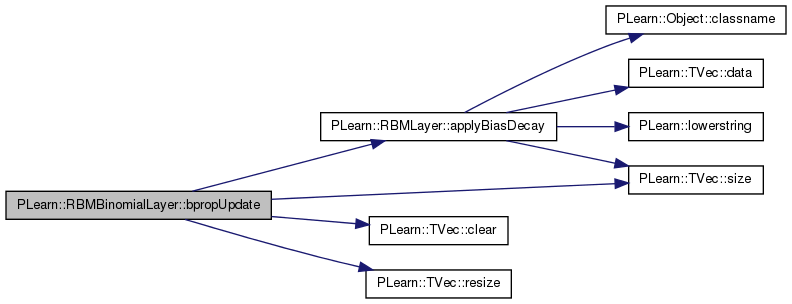
| void PLearn::RBMBinomialLayer::bpropUpdate | ( | const Vec & | input, |
| const Vec & | rbm_bias, | ||
| const Vec & | output, | ||
| Vec & | input_gradient, | ||
| Vec & | rbm_bias_gradient, | ||
| const Vec & | output_gradient | ||
| ) | [virtual] |
back-propagates the output gradient to the input and the bias
TODO: add "accumulate" here.
Reimplemented from PLearn::RBMLayer.
Definition at line 427 of file RBMBinomialLayer.cc.
References i, PLASSERT, PLearn::TVec< T >::resize(), PLearn::TVec< T >::size(), PLearn::RBMLayer::size, and use_signed_samples.
{
PLASSERT( input.size() == size );
PLASSERT( rbm_bias.size() == size );
PLASSERT( output.size() == size );
PLASSERT( output_gradient.size() == size );
input_gradient.resize( size );
rbm_bias_gradient.resize( size );
if( use_signed_samples )
{
for( int i=0 ; i<size ; i++ )
{
real output_i = output[i];
input_gradient[i] = ( 1 - output_i * output_i ) * output_gradient[i];
}
}
else
{
for( int i=0 ; i<size ; i++ )
{
real output_i = output[i];
input_gradient[i] = output_i * (1-output_i) * output_gradient[i];
}
}
rbm_bias_gradient << input_gradient;
}

| void PLearn::RBMBinomialLayer::bpropUpdate | ( | const Mat & | inputs, |
| const Mat & | outputs, | ||
| Mat & | input_gradients, | ||
| const Mat & | output_gradients, | ||
| bool | accumulate = false |
||
| ) | [virtual] |
Back-propagate the output gradient to the input, and update parameters.
Implements PLearn::RBMLayer.
Definition at line 331 of file RBMBinomialLayer.cc.
References PLearn::RBMLayer::applyBiasDecay(), PLearn::RBMLayer::bias, PLearn::RBMLayer::bias_inc, PLearn::TMat< T >::clear(), i, j, PLearn::RBMLayer::learning_rate, PLearn::TMat< T >::length(), PLearn::RBMLayer::momentum, PLASSERT, PLASSERT_MSG, PLERROR, PLearn::TMat< T >::resize(), PLearn::TVec< T >::resize(), PLearn::RBMLayer::size, use_signed_samples, and PLearn::TMat< T >::width().
{
PLASSERT( inputs.width() == size );
PLASSERT( outputs.width() == size );
PLASSERT( output_gradients.width() == size );
int mbatch_size = inputs.length();
PLASSERT( outputs.length() == mbatch_size );
PLASSERT( output_gradients.length() == mbatch_size );
if( accumulate )
{
PLASSERT_MSG( input_gradients.width() == size &&
input_gradients.length() == mbatch_size,
"Cannot resize input_gradients and accumulate into it" );
}
else
{
input_gradients.resize(mbatch_size, size);
input_gradients.clear();
}
if( momentum != 0. )
bias_inc.resize( size );
// TODO Can we do this more efficiently? (using BLAS)
// We use the average gradient over the mini-batch.
real avg_lr = learning_rate / inputs.length();
if( use_signed_samples )
{
for (int j = 0; j < mbatch_size; j++)
{
for( int i=0 ; i<size ; i++ )
{
real output_i = outputs(j, i);
real in_grad_i;
in_grad_i = (1 - output_i * output_i) * output_gradients(j, i);
input_gradients(j, i) += in_grad_i;
if( momentum == 0. )
{
// update the bias: bias -= learning_rate * input_gradient
bias[i] -= avg_lr * in_grad_i;
}
else
{
PLERROR("In RBMBinomialLayer:bpropUpdate - Not implemented for "
"momentum with mini-batches");
// The update rule becomes:
// bias_inc = momentum * bias_inc - learning_rate * input_gradient
// bias += bias_inc
bias_inc[i] = momentum * bias_inc[i] - learning_rate * in_grad_i;
bias[i] += bias_inc[i];
}
}
}
}
else
{
for (int j = 0; j < mbatch_size; j++)
{
for( int i=0 ; i<size ; i++ )
{
real output_i = outputs(j, i);
real in_grad_i;
in_grad_i = output_i * (1-output_i) * output_gradients(j, i);
input_gradients(j, i) += in_grad_i;
if( momentum == 0. )
{
// update the bias: bias -= learning_rate * input_gradient
bias[i] -= avg_lr * in_grad_i;
}
else
{
PLERROR("In RBMBinomialLayer:bpropUpdate - Not implemented for "
"momentum with mini-batches");
// The update rule becomes:
// bias_inc = momentum * bias_inc - learning_rate * input_gradient
// bias += bias_inc
bias_inc[i] = momentum * bias_inc[i] - learning_rate * in_grad_i;
bias[i] += bias_inc[i];
}
}
}
}
applyBiasDecay();
}
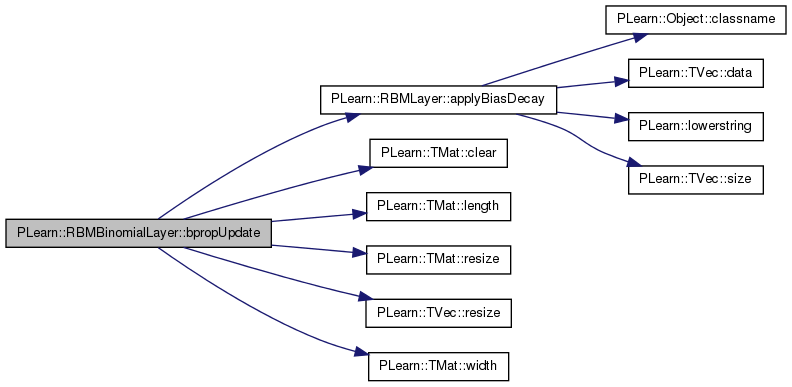
| void PLearn::RBMBinomialLayer::build | ( | ) | [virtual] |
Post-constructor.
The normal implementation should call simply inherited::build(), then this class's build_(). This method should be callable again at later times, after modifying some option fields to change the "architecture" of the object.
Reimplemented from PLearn::RBMLayer.
Definition at line 144 of file DEPRECATED/RBMBinomialLayer.cc.
{
inherited::build();
build_();
}
| virtual void PLearn::RBMBinomialLayer::build | ( | ) | [virtual] |
Post-constructor.
The normal implementation should call simply inherited::build(), then this class's build_(). This method should be callable again at later times, after modifying some option fields to change the "architecture" of the object.
Reimplemented from PLearn::RBMLayer.
| void PLearn::RBMBinomialLayer::build_ | ( | ) | [private] |
This does the actual building.
Reimplemented from PLearn::RBMLayer.
Definition at line 131 of file DEPRECATED/RBMBinomialLayer.cc.
References PLearn::TVec< T >::resize(), and PLearn::sample().
{
if( size < 0 )
size = int(units_types.size());
if( size != (int) units_types.size() )
units_types = string( size, 'l' );
activations.resize( size );
sample.resize( size );
expectation.resize( size );
expectation_is_up_to_date = false;
}

| void PLearn::RBMBinomialLayer::build_ | ( | ) | [private] |
This does the actual building.
Reimplemented from PLearn::RBMLayer.
| virtual string PLearn::RBMBinomialLayer::classname | ( | ) | const [virtual] |
Reimplemented from PLearn::Object.
| string PLearn::RBMBinomialLayer::classname | ( | ) | const [virtual] |
Reimplemented from PLearn::Object.
Definition at line 49 of file DEPRECATED/RBMBinomialLayer.cc.
| void PLearn::RBMBinomialLayer::computeExpectation | ( | ) | [virtual] |
compute the expectation
Implements PLearn::RBMLayer.
Definition at line 91 of file DEPRECATED/RBMBinomialLayer.cc.
References i, and PLearn::sigmoid().
Referenced by bpropNLL().
{
if( expectation_is_up_to_date )
return;
for( int i=0 ; i<size ; i++ )
expectation[i] = sigmoid( -activations[i] );
expectation_is_up_to_date = true;
}


| virtual void PLearn::RBMBinomialLayer::computeExpectation | ( | ) | [virtual] |
Compute expectation.
Implements PLearn::RBMLayer.
| void PLearn::RBMBinomialLayer::computeExpectations | ( | ) | [virtual] |
Compute mini-batch expectations.
Implements PLearn::RBMLayer.
Definition at line 150 of file RBMBinomialLayer.cc.
References PLearn::RBMLayer::activations, PLearn::RBMLayer::batch_size, PLearn::RBMLayer::expectations, PLearn::RBMLayer::expectations_are_up_to_date, PLearn::fastsigmoid(), PLearn::fasttanh(), PLearn::TMat< T >::length(), PLearn::TVec< T >::length(), PLASSERT, PLearn::sigmoid(), PLearn::RBMLayer::size, PLearn::tanh(), PLearn::OnlineLearningModule::use_fast_approximations, use_signed_samples, and PLearn::TMat< T >::width().
Referenced by bpropNLL().
{
PLASSERT( activations.length() == batch_size );
if( expectations_are_up_to_date )
return;
PLASSERT( expectations.width() == size
&& expectations.length() == batch_size );
if( use_signed_samples )
if (use_fast_approximations)
for (int k = 0; k < batch_size; k++)
for (int i = 0 ; i < size ; i++)
expectations(k, i) = fasttanh(activations(k, i));
else
for (int k = 0; k < batch_size; k++)
for (int i = 0 ; i < size ; i++)
expectations(k, i) = tanh(activations(k, i));
else
if (use_fast_approximations)
for (int k = 0; k < batch_size; k++)
for (int i = 0 ; i < size ; i++)
expectations(k, i) = fastsigmoid(activations(k, i));
else
for (int k = 0; k < batch_size; k++)
for (int i = 0 ; i < size ; i++)
expectations(k, i) = sigmoid(activations(k, i));
expectations_are_up_to_date = true;
}


| void PLearn::RBMBinomialLayer::declareOptions | ( | OptionList & | ol | ) | [static, protected] |
Declares the class options.
Reimplemented from PLearn::RBMLayer.
Definition at line 120 of file DEPRECATED/RBMBinomialLayer.cc.
{
/*
declareOption(ol, "size", &RBMBinomialLayer::size,
OptionBase::buildoption,
"Number of units.");
*/
// Now call the parent class' declareOptions
inherited::declareOptions(ol);
}
| static void PLearn::RBMBinomialLayer::declareOptions | ( | OptionList & | ol | ) | [static, protected] |
Declares the class options.
Reimplemented from PLearn::RBMLayer.
| static const PPath& PLearn::RBMBinomialLayer::declaringFile | ( | ) | [inline, static] |
Reimplemented from PLearn::RBMLayer.
Definition at line 97 of file DEPRECATED/RBMBinomialLayer.h.
:
//##### Not Options #####################################################
| static const PPath& PLearn::RBMBinomialLayer::declaringFile | ( | ) | [inline, static] |
Reimplemented from PLearn::RBMLayer.
Definition at line 149 of file RBMBinomialLayer.h.
:
//##### Not Options #####################################################
| virtual RBMBinomialLayer* PLearn::RBMBinomialLayer::deepCopy | ( | CopiesMap & | copies | ) | const [virtual] |
Reimplemented from PLearn::RBMLayer.
| RBMBinomialLayer * PLearn::RBMBinomialLayer::deepCopy | ( | CopiesMap & | copies | ) | const [virtual] |
Reimplemented from PLearn::RBMLayer.
Definition at line 49 of file DEPRECATED/RBMBinomialLayer.cc.
compute -bias' unit_values
Reimplemented from PLearn::RBMLayer.
Definition at line 694 of file RBMBinomialLayer.cc.
References PLearn::RBMLayer::bias, and PLearn::dot().

forward propagation
Reimplemented from PLearn::RBMLayer.
Definition at line 183 of file RBMBinomialLayer.cc.
References PLearn::RBMLayer::bias, PLearn::fastsigmoid(), PLearn::fasttanh(), PLearn::OnlineLearningModule::input_size, PLearn::OnlineLearningModule::output_size, PLASSERT, PLearn::TVec< T >::resize(), PLearn::sigmoid(), PLearn::RBMLayer::size, PLearn::TVec< T >::size(), PLearn::tanh(), PLearn::OnlineLearningModule::use_fast_approximations, and use_signed_samples.
{
PLASSERT( input.size() == input_size );
output.resize( output_size );
if( use_signed_samples )
if (use_fast_approximations)
for( int i=0 ; i<size ; i++ )
output[i] = fasttanh( input[i] + bias[i] );
else
for( int i=0 ; i<size ; i++ )
output[i] = tanh( input[i] + bias[i] );
else
if (use_fast_approximations)
for( int i=0 ; i<size ; i++ )
output[i] = fastsigmoid( input[i] + bias[i] );
else
for( int i=0 ; i<size ; i++ )
output[i] = sigmoid( input[i] + bias[i] );
}

Batch forward propagation.
Reimplemented from PLearn::RBMLayer.
Definition at line 204 of file RBMBinomialLayer.cc.
References PLearn::RBMLayer::bias, PLearn::fastsigmoid(), PLearn::fasttanh(), PLearn::TMat< T >::length(), PLASSERT, PLearn::TMat< T >::resize(), PLearn::sigmoid(), PLearn::RBMLayer::size, PLearn::tanh(), PLearn::OnlineLearningModule::use_fast_approximations, use_signed_samples, and PLearn::TMat< T >::width().
{
int mbatch_size = inputs.length();
PLASSERT( inputs.width() == size );
outputs.resize( mbatch_size, size );
if( use_signed_samples )
if (use_fast_approximations)
for( int k = 0; k < mbatch_size; k++ )
for( int i = 0; i < size; i++ )
outputs(k,i) = fasttanh( inputs(k,i) + bias[i] );
else
for( int k = 0; k < mbatch_size; k++ )
for( int i = 0; i < size; i++ )
outputs(k,i) = tanh( inputs(k,i) + bias[i] );
else
if (use_fast_approximations)
for( int k = 0; k < mbatch_size; k++ )
for( int i = 0; i < size; i++ )
outputs(k,i) = fastsigmoid( inputs(k,i) + bias[i] );
else
for( int k = 0; k < mbatch_size; k++ )
for( int i = 0; i < size; i++ )
outputs(k,i) = sigmoid( inputs(k,i) + bias[i] );
}
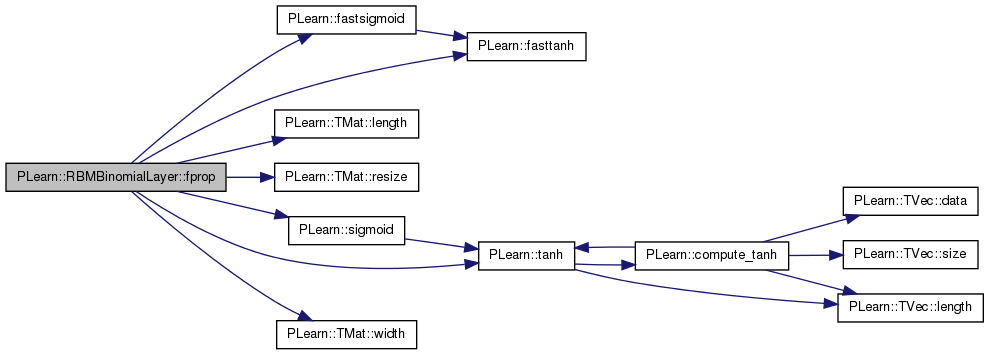
| void PLearn::RBMBinomialLayer::fprop | ( | const Vec & | input, |
| const Vec & | rbm_bias, | ||
| Vec & | output | ||
| ) | const [virtual] |
forward propagation with provided bias
Reimplemented from PLearn::RBMLayer.
Definition at line 231 of file RBMBinomialLayer.cc.
References PLearn::fastsigmoid(), PLearn::fasttanh(), PLearn::OnlineLearningModule::input_size, PLearn::OnlineLearningModule::output_size, PLASSERT, PLearn::TVec< T >::resize(), PLearn::sigmoid(), PLearn::TVec< T >::size(), PLearn::RBMLayer::size, PLearn::tanh(), PLearn::OnlineLearningModule::use_fast_approximations, and use_signed_samples.
{
PLASSERT( input.size() == input_size );
PLASSERT( rbm_bias.size() == input_size );
output.resize( output_size );
if( use_signed_samples )
if (use_fast_approximations)
for( int i=0 ; i<size ; i++ )
output[i] = fasttanh( input[i] + rbm_bias[i]);
else
for( int i=0 ; i<size ; i++ )
output[i] =tanh( input[i] + rbm_bias[i]);
else
if (use_fast_approximations)
for( int i=0 ; i<size ; i++ )
output[i] = fastsigmoid( input[i] + rbm_bias[i]);
else
for( int i=0 ; i<size ; i++ )
output[i] = sigmoid( input[i] + rbm_bias[i]);
}

Computes the negative log-likelihood of target given the internal activations of the layer.
Reimplemented from PLearn::RBMLayer.
Definition at line 460 of file RBMBinomialLayer.cc.
References PLearn::RBMLayer::activation, i, PLearn::OnlineLearningModule::input_size, PLASSERT, PLearn::TVec< T >::size(), PLearn::RBMLayer::size, PLearn::softplus(), PLearn::tabulated_softplus(), PLearn::OnlineLearningModule::use_fast_approximations, and use_signed_samples.
{
PLASSERT( target.size() == input_size );
real ret = 0;
real target_i, activation_i;
if( use_signed_samples )
{
if(use_fast_approximations){
for( int i=0 ; i<size ; i++ )
{
target_i = (target[i]+1)/2;
activation_i = 2*activation[i];
ret += tabulated_softplus(activation_i) - target_i * activation_i;
// nll = - target*log(sigmoid(act)) -(1-target)*log(1-sigmoid(act))
// but it is numerically unstable, so use instead the following identity:
// = target*softplus(-act) +(1-target)*(act+softplus(-act))
// = act + softplus(-act) - target*act
// = softplus(act) - target*act
}
} else {
for( int i=0 ; i<size ; i++ )
{
target_i = (target[i]+1)/2;
activation_i = 2*activation[i];
ret += softplus(activation_i) - target_i * activation_i;
}
}
}
else
{
if(use_fast_approximations){
for( int i=0 ; i<size ; i++ )
{
target_i = target[i];
activation_i = activation[i];
ret += tabulated_softplus(activation_i) - target_i * activation_i;
// nll = - target*log(sigmoid(act)) -(1-target)*log(1-sigmoid(act))
// but it is numerically unstable, so use instead the following identity:
// = target*softplus(-act) +(1-target)*(act+softplus(-act))
// = act + softplus(-act) - target*act
// = softplus(act) - target*act
}
} else {
for( int i=0 ; i<size ; i++ )
{
target_i = target[i];
activation_i = activation[i];
ret += softplus(activation_i) - target_i * activation_i;
}
}
}
return ret;
}

Computes the weighted negative log-likelihood of target given the internal activations of the layer.
Reimplemented from PLearn::RBMLayer.
Definition at line 516 of file RBMBinomialLayer.cc.
References PLearn::RBMLayer::activation, i, PLearn::OnlineLearningModule::input_size, PLASSERT, PLearn::TVec< T >::size(), PLearn::RBMLayer::size, PLearn::softplus(), PLearn::tabulated_softplus(), PLearn::OnlineLearningModule::use_fast_approximations, and use_signed_samples.
{
PLASSERT( target.size() == input_size );
PLASSERT( target.size() == cost_weights.size() );
PLASSERT (cost_weights.size() == size );
real ret = 0;
real target_i, activation_i;
if( use_signed_samples )
{
if(use_fast_approximations){
for( int i=0 ; i<size ; i++ )
{
if(cost_weights[i] != 0)
{
target_i = (target[i]+1)/2;
activation_i = 2*activation[i];
ret += cost_weights[i]*(tabulated_softplus(activation_i) - target_i * activation_i);
}
// nll = - target*log(sigmoid(act)) -(1-target)*log(1-sigmoid(act))
// but it is numerically unstable, so use instead the following identity:
// = target*softplus(-act) +(1-target)*(act+softplus(-act))
// = act + softplus(-act) - target*act
// = softplus(act) - target*act
}
} else {
for( int i=0 ; i<size ; i++ )
{
if(cost_weights[i] != 0)
{
target_i = (target[i]+1)/2;
activation_i = 2*activation[i];
ret += cost_weights[i]*(softplus(activation_i) - target_i * activation_i);
}
}
}
}
else
{
if(use_fast_approximations){
for( int i=0 ; i<size ; i++ )
{
if(cost_weights[i] != 0)
{
target_i = target[i];
activation_i = activation[i];
ret += cost_weights[i]*(tabulated_softplus(activation_i) - target_i * activation_i);
}
// nll = - target*log(sigmoid(act)) -(1-target)*log(1-sigmoid(act))
// but it is numerically unstable, so use instead the following identity:
// = target*softplus(-act) +(1-target)*(act+softplus(-act))
// = act + softplus(-act) - target*act
// = softplus(act) - target*act
}
} else {
for( int i=0 ; i<size ; i++ )
{
if(cost_weights[i] != 0)
{
target_i = target[i];
activation_i = activation[i];
ret += cost_weights[i]*(softplus(activation_i) - target_i * activation_i);
}
}
}
}
return ret;
}

Reimplemented from PLearn::RBMLayer.
Definition at line 588 of file RBMBinomialLayer.cc.
References PLearn::RBMLayer::activation, PLearn::RBMLayer::activations, PLearn::RBMLayer::batch_size, i, PLearn::OnlineLearningModule::input_size, PLearn::TMat< T >::length(), PLASSERT, PLearn::RBMLayer::size, PLearn::softplus(), PLearn::tabulated_softplus(), PLearn::OnlineLearningModule::use_fast_approximations, use_signed_samples, and PLearn::TMat< T >::width().
{
PLASSERT( targets.width() == input_size );
PLASSERT( targets.length() == batch_size );
PLASSERT( costs_column.width() == 1 );
PLASSERT( costs_column.length() == batch_size );
if( use_signed_samples )
{
for (int k=0;k<batch_size;k++) // loop over minibatch
{
real nll = 0;
real* activation = activations[k];
real* target = targets[k];
if(use_fast_approximations){
for( int i=0 ; i<size ; i++ ) // loop over outputs
{
nll += tabulated_softplus(2*activation[i])
- (target[i]+1) * activation[i] ;
}
} else {
for( int i=0 ; i<size ; i++ ) // loop over outputs
{
nll += softplus(2*activation[i]) - (target[i]+1)*activation[i] ;
}
}
costs_column(k,0) = nll;
}
}
else
{
for (int k=0;k<batch_size;k++) // loop over minibatch
{
real nll = 0;
real* activation = activations[k];
real* target = targets[k];
if(use_fast_approximations){
for( int i=0 ; i<size ; i++ ) // loop over outputs
{
nll += tabulated_softplus(activation[i])
-target[i] * activation[i] ;
}
} else {
for( int i=0 ; i<size ; i++ ) // loop over outputs
{
nll += softplus(activation[i]) - target[i] * activation[i] ;
}
}
costs_column(k,0) = nll;
}
}
}

| real PLearn::RBMBinomialLayer::freeEnergyContribution | ( | const Vec & | unit_activations | ) | const [virtual] |
Computes  ) This quantity is used for computing the free energy of a sample x in the OTHER layer of an RBM, from which unit_activations was computed.
) This quantity is used for computing the free energy of a sample x in the OTHER layer of an RBM, from which unit_activations was computed.
Reimplemented from PLearn::RBMLayer.
Definition at line 699 of file RBMBinomialLayer.cc.
References a, PLearn::TVec< T >::data(), i, PLASSERT, PLearn::TVec< T >::size(), PLearn::RBMLayer::size, PLearn::softplus(), PLearn::tabulated_softplus(), PLearn::OnlineLearningModule::use_fast_approximations, and use_signed_samples.
{
PLASSERT( unit_activations.size() == size );
// result = -\sum_{i=0}^{size-1} softplus(a_i)
real result = 0;
real* a = unit_activations.data();
if( use_signed_samples )
{
for (int i=0; i<size; i++)
{
if (use_fast_approximations)
result -= tabulated_softplus(2*a[i]) - a[i];
else
result -= softplus(2*a[i]) - a[i];
}
}
else
{
for (int i=0; i<size; i++)
{
if (use_fast_approximations)
result -= tabulated_softplus(a[i]);
else
result -= softplus(a[i]);
}
}
return result;
}

| void PLearn::RBMBinomialLayer::freeEnergyContributionGradient | ( | const Vec & | unit_activations, |
| Vec & | unit_activations_gradient, | ||
| real | output_gradient = 1, |
||
| bool | accumulate = false |
||
| ) | const [virtual] |
Computes gradient of the result of freeEnergyContribution  with respect to unit_activations.
with respect to unit_activations.
Optionally, a gradient with respect to freeEnergyContribution can be given
Reimplemented from PLearn::RBMLayer.
Definition at line 730 of file RBMBinomialLayer.cc.
References a, PLearn::TVec< T >::clear(), PLearn::TVec< T >::data(), PLearn::fastsigmoid(), PLearn::fasttanh(), i, PLASSERT, PLearn::TVec< T >::resize(), PLearn::sigmoid(), PLearn::TVec< T >::size(), PLearn::RBMLayer::size, PLearn::tanh(), PLearn::OnlineLearningModule::use_fast_approximations, and use_signed_samples.
{
PLASSERT( unit_activations.size() == size );
unit_activations_gradient.resize( size );
if( !accumulate ) unit_activations_gradient.clear();
real* a = unit_activations.data();
real* ga = unit_activations_gradient.data();
if( use_signed_samples )
{
for (int i=0; i<size; i++)
{
if (use_fast_approximations)
ga[i] -= output_gradient *
( fasttanh( a[i] ) );
else
ga[i] -= output_gradient *
( tanh( a[i] ) );
}
}
else
{
for (int i=0; i<size; i++)
{
if (use_fast_approximations)
ga[i] -= output_gradient *
fastsigmoid( a[i] );
else
ga[i] -= output_gradient *
sigmoid( a[i] );
}
}
}
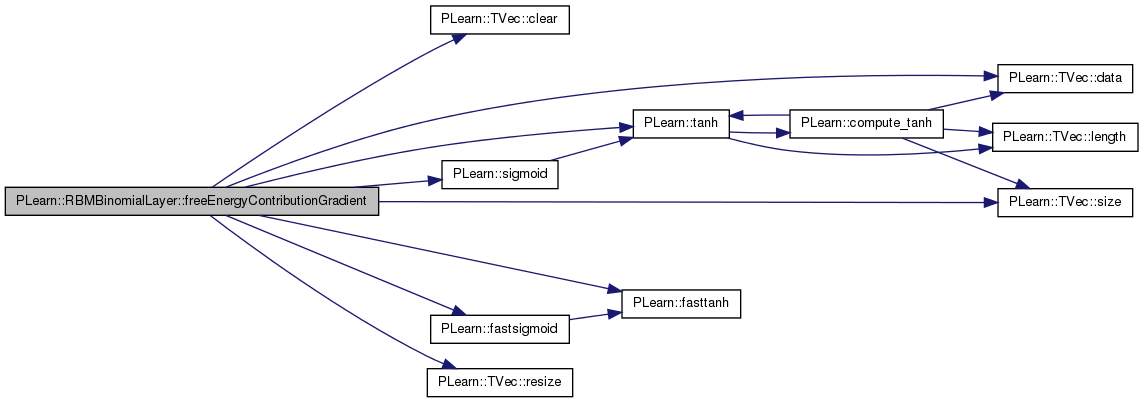
| virtual void PLearn::RBMBinomialLayer::generateSample | ( | ) | [virtual] |
generate a sample, and update the sample field
Implements PLearn::RBMLayer.
| void PLearn::RBMBinomialLayer::generateSample | ( | ) | [virtual] |
generate a sample, and update the sample field
Implements PLearn::RBMLayer.
Definition at line 83 of file DEPRECATED/RBMBinomialLayer.cc.
References i, and PLearn::sample().
{
computeExpectation();
for( int i=0 ; i<size ; i++ )
sample[i] = random_gen->binomial_sample( expectation[i] );
}

| void PLearn::RBMBinomialLayer::generateSamples | ( | ) | [virtual] |
Inherited.
Implements PLearn::RBMLayer.
Definition at line 96 of file RBMBinomialLayer.cc.
References PLearn::RBMLayer::batch_size, PLearn::RBMLayer::expectations, PLearn::RBMLayer::expectations_are_up_to_date, i, PLearn::TMat< T >::length(), PLASSERT, PLASSERT_MSG, PLCHECK_MSG, PLearn::RBMLayer::random_gen, PLearn::RBMLayer::samples, PLearn::RBMLayer::size, use_signed_samples, and PLearn::TMat< T >::width().
{
PLASSERT_MSG(random_gen,
"random_gen should be initialized before generating samples");
PLCHECK_MSG(expectations_are_up_to_date, "Expectations should be computed "
"before calling generateSamples()");
PLASSERT( samples.width() == size && samples.length() == batch_size );
//random_gen->manual_seed(1827);
if( use_signed_samples )
for (int k = 0; k < batch_size; k++) {
for (int i=0 ; i<size ; i++)
samples(k, i) = 2*random_gen->binomial_sample( (expectations(k, i)+1)/2 )-1;
}
else
for (int k = 0; k < batch_size; k++) {
for (int i=0 ; i<size ; i++)
samples(k, i) = random_gen->binomial_sample( expectations(k, i) );
}
}

| void PLearn::RBMBinomialLayer::getAllActivations | ( | PP< RBMParameters > | rbmp, |
| int | offset = 0 |
||
| ) | [virtual] |
Uses "rbmp" to obtain the activations of all units in this layer.
Unit 0 of this layer corresponds to unit "offset" of "rbmp".
Implements PLearn::RBMLayer.
Definition at line 77 of file DEPRECATED/RBMBinomialLayer.cc.
{
rbmp->computeUnitActivations( offset, size, activations );
expectation_is_up_to_date = false;
}
Computes the conf_index configuration of the layer.
Reimplemented from PLearn::RBMLayer.
Definition at line 771 of file RBMBinomialLayer.cc.
References getConfigurationCount(), i, PLearn::TVec< T >::length(), PLASSERT, PLearn::RBMLayer::size, and use_signed_samples.
{
PLASSERT( output.length() == size );
PLASSERT( conf_index >= 0 && conf_index < getConfigurationCount() );
if( use_signed_samples )
{
for ( int i = 0; i < size; ++i ) {
output[i] = 2 * (conf_index & 1) - 1;
conf_index >>= 1;
}
}
else
{
for ( int i = 0; i < size; ++i ) {
output[i] = conf_index & 1;
conf_index >>= 1;
}
}
}

| int PLearn::RBMBinomialLayer::getConfigurationCount | ( | ) | [virtual] |
Returns a number of different configurations the layer can be in.
Reimplemented from PLearn::RBMLayer.
Definition at line 766 of file RBMBinomialLayer.cc.
References PLearn::RBMLayer::INFINITE_CONFIGURATIONS.
Referenced by getConfiguration().
{
return size < 31 ? 1<<size : INFINITE_CONFIGURATIONS;
}

| virtual OptionList& PLearn::RBMBinomialLayer::getOptionList | ( | ) | const [virtual] |
Reimplemented from PLearn::Object.
| OptionList & PLearn::RBMBinomialLayer::getOptionList | ( | ) | const [virtual] |
Reimplemented from PLearn::Object.
Definition at line 49 of file DEPRECATED/RBMBinomialLayer.cc.
| OptionMap & PLearn::RBMBinomialLayer::getOptionMap | ( | ) | const [virtual] |
Reimplemented from PLearn::Object.
Definition at line 49 of file DEPRECATED/RBMBinomialLayer.cc.
| virtual OptionMap& PLearn::RBMBinomialLayer::getOptionMap | ( | ) | const [virtual] |
Reimplemented from PLearn::Object.
| RemoteMethodMap & PLearn::RBMBinomialLayer::getRemoteMethodMap | ( | ) | const [virtual] |
Reimplemented from PLearn::Object.
Definition at line 49 of file DEPRECATED/RBMBinomialLayer.cc.
| virtual RemoteMethodMap& PLearn::RBMBinomialLayer::getRemoteMethodMap | ( | ) | const [virtual] |
Reimplemented from PLearn::Object.
| void PLearn::RBMBinomialLayer::getUnitActivations | ( | int | i, |
| PP< RBMParameters > | rbmp, | ||
| int | offset = 0 |
||
| ) | [virtual] |
Uses "rbmp" to obtain the activations of unit "i" of this layer.
This activation vector is computed by the "i+offset"-th unit of "rbmp"
Implements PLearn::RBMLayer.
Definition at line 67 of file DEPRECATED/RBMBinomialLayer.cc.
References PLearn::TVec< T >::subVec().
{
Vec activation = activations.subVec( i, 1 );
rbmp->computeUnitActivations( i+offset, 1, activation );
expectation_is_up_to_date = false;
}

| virtual void PLearn::RBMBinomialLayer::makeDeepCopyFromShallowCopy | ( | CopiesMap & | copies | ) | [virtual] |
Transforms a shallow copy into a deep copy.
Reimplemented from PLearn::RBMLayer.
| void PLearn::RBMBinomialLayer::makeDeepCopyFromShallowCopy | ( | CopiesMap & | copies | ) | [virtual] |
Transforms a shallow copy into a deep copy.
Reimplemented from PLearn::RBMLayer.
Definition at line 151 of file DEPRECATED/RBMBinomialLayer.cc.
{
inherited::makeDeepCopyFromShallowCopy(copies);
}
static StaticInitializer PLearn::RBMBinomialLayer::_static_initializer_ [static] |
Reimplemented from PLearn::RBMLayer.
Definition at line 97 of file DEPRECATED/RBMBinomialLayer.h.
Definition at line 60 of file RBMBinomialLayer.h.
Referenced by bpropUpdate(), computeExpectations(), fprop(), fpropNLL(), freeEnergyContribution(), freeEnergyContributionGradient(), generateSamples(), and getConfiguration().
 1.7.4
1.7.4